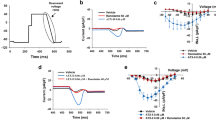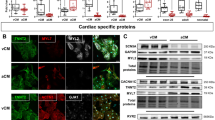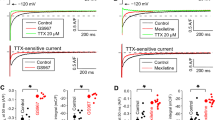Abstract
Aim:
Tetrandrine (Tet) is a Ca2+ channel blocker and has antiarrhythmic effects. Less information exists with regard to the mechanisms underlying its antiarrhythmic action other than blocking Ca2+ channels. In this study, the effects of Tet on the Na+ current (INa) in the atrial myocardium of patients in atrial fibrillation (AF) and sinus rhythm (SR) were investigated, and the characteristics of the Na+ current were synchronously compared between the AF and SR patients.
Methods:
Na+ currents were recorded using the whole-cell patch clamp technique in single atrial myocyte of the AF and the normal SR groups. The effects of Tet (40–120 μmol/L) on the Na+ current in the two groups were then observed.
Results:
Tet (60–120 μmol/L) decreased INa density in a concentration-dependent manner and made the voltage-dependent activation curve shift to more positive voltages in the SR and AF groups. After exposure to Tet, the voltage-dependent inactivation curve of INa was shifted to more negative voltages in the two groups. Tet delayed the time-dependent recovery of INa in a concentration dependent manner in both AF and SR cells; however, there were no differences in the effects of Tet on INa density and properties in the two groups. The INa density of AF patients did not differ from that of the SR patients.
Conclusion:
Tet can block sodium channels with slow recovery kinetics, which may explain the mechanisms underlying the antiarrhythmic action of Tet. The decreased conduction velocity (CV) in AF patients is not caused by the Na+ current.
Similar content being viewed by others
Log in or create a free account to read this content
Gain free access to this article, as well as selected content from this journal and more on nature.com
or
References
Gaspo R, Bosch RF, Talajic M, Nattel S . Functional mechanisms underlying tachycardia-induced sustained atrial fibrillation in a chronic dog model. Circulation 1997; 96: 4027–35.
Shinagawa K, Shiroshita-Takeshita A, Schram G, Nattel S . Effects of antiarrhythmic drugs on fibrillation in the remodeled atrium: insights into the mechanism of the superior efficacy of amiodarone. Circulation 2003; 107: 1440–6.
Ashikaga K, Kobayashi T, Kimura M, Owada S, Sasaki S, Iwasa A, et al. Effects of amiodarone on electrical and structural remodeling induced in a canine rapid pacing-induced persistent atrial fibrillation model. Eur J Pharmacol 2006; 536: 148–53.
Gaspo R, Bosch RF, Elias BA, Nattel S . Tachycardia-induced changes in Na+ current in a chronic dog model of atrial fibrillation. Circ Res 1997; 81: 1045–52.
Wong TM, Wu S, Yu XC, Li HY . Cardiovascular actions of Radix Stephaniae Tetrandrae: a comparison with its main component, tetrandrine. Acta Pharmacol Sin 2000; 21: 1083–8.
Cha L, Qian JQ, Lue FH . Antiarrhythmic action of tetrandrine and the total alkaloids of sophora flavescens. Acta Pharmacol Sin 1981; 2: 26–8.
Jiang JQ, Zeng QT, Cao LS . Effects of tetrandrine on early after depolarizations and arrhythmias induced by cesium chloride in rabbits. J Cardiovasc Pulm Dis 2002; 21: 239–41. Chinese.
Yu XC, Wu S, Wang GY, Shan J . Cardiac effects of the extract and active components of radix stephaniae tetrandrae. II. Myocardial infarct, arrhythmias, coronary arterial flow and heart rate in the isolated perfused rat heart. Life Sci 2001; 68: 2863–72.
Yu XC, Wu S, Chen CF, Pang KT, Wong TM . Antihypertensive and anti-arrhythmic effects of an extract of Radix Stephaniae Tetrandrae in the rat. J Pharm Pharmacol 2004; 56: 115–22.
Li WH . The clinical cardiac electrophysiologic effects of tetrandrine. Zhonghua Xin Xue Guan Bing Za Zhi 1993; 21: 225–54. Chinese.
Liu QY, Karpinski E, Pang PK . Tetrandrine inhibits both T and L calcium channel current in ventricular cells. J Cardiovasc Pharmacol 1992; 20: 513–9.
Wu SN, Hwang TL, Jan CR, Tseng CJ . Ionic mechanisms of tetrandrine in cultured rat aortic smooth muscle cells. Eur J Pharmacol 1997; 327: 233–8.
Zhou HY, Wang F, Cheng L, Fu LY, Zhou J, Yao WX . Effects of tetrandrine on calcium and potassium currents in isolated rat hepatocytes. World J Gastroenterol 2003; 9: 134–6.
Bosch RF, Zeng X, Grammer JB, Popovic K, Mewis C, Kühlkamp V . Ionic mechanisms of electrical remodeling in human atrial fibrillation. Cardiovasc Res 1999, 44: 121–31.
Yue L, Melnyk P, Gaspo R . Molecular mechanisms underlying ionic remodeling in a dog model of atrial fibrillation. Cir Res 1999; 84: 776–84.
Nao T, Ohkusa T, Hisamatsu Y, Inoue N, Matsumoto T, Yamada J, et al. Comparison of expression of connexin in right atrial myocardium in patients with chronic atrial fibrillation versus those in sinus rhythm. Am J Cardiol 2003; 91: 678–83.
Wilhelm M, Kirste W, Kuly S, Amann K, Neuhuber W, Weyand M, et al. Atrial distribution of connexin 40 and 43 in patients with intermittent, persistent, and postoperative atrial fibrillation. Heart Lung Circ 2006; 15: 30–7.
Moe GK, Rheinboldt WC, Abildskov JA . A computer model of atrial fibrillation. Am Heart J 1964; 67: 200–20.
Allessie M, Lammers WJ, Bonke FI, Hollen J . Experimental evaluation of Moe's multiple wavelet hypothesis of atrial fibrillation. In: Zipes DP, Jalife J, eds. Cardiac electrophysiology and arrhythmias. New York: Grune & Stratton, 1985: 265–75.
Mandapati R, Skanes A, Chen J, Berenfeld O, Jalife J . Stable microreentrant sources as a mechanism of atrial fibrillation in the isolated sheep heart. Circulation 2000; 101: 194–9.
Nash MP, Mourad A, Clayton RH, Sutton PM, Bradley CP, Hayward M, et al. Evidence for multiple mechanisms in human ventricular fibrillation. Circulation 2006; 114: 536–42.
Chou CC, Zhou S, Miyauchi Y, Pak HN, Okuyama Y, Fishbein MC, et al. Effects of procainamide on electrical activity in thoracic veins and atria in canine model of sustained atrial fibrillation. Am J Physiol Heart Circ Physiol 2004; 286: H1936–45.
Nattel S, Kneller J, Zou R, Leon LJ . Mechanisms of termination of atrial fibrillation by class I antiarrhythmic drugs: evidence from clinical, experimental, and mathematical modeling studies. J Cardiovasc Electrophysiol 2003; 14: S133–9.
Kawase A, Ikeda T, Nakazawa K, Ashihara T, Namba T, Kubota T, et al. Widening of the excitable gap and enlargement of the core of reentry during atrial fibrillation with a pure sodium channel blocker in canine atria. Circulation 2003; 107: 905–10.
Kneller J, Kalifa J, Zou R, Zaitsev AV, Warren M, Berenfeld O, et al. Mechanisms of AF termination by pure sodium channel blockade in an ionically-realistic mathematical model. Circ Res 2005; 96: e35–47.
Hondeghem LM, Katzung BG . Time-and voltage-dependent interaction of antiarrhythmic drugs with cardiac sodium channels. Biochim Biophys Acta 1977; 472: 373–98.
Kanki H, Mitamura H, Takatsuki S, Sueyoshi K, Shinagawa K, Sato T, et al. Postrepolarization refractoriness as a potential anti-atrial fibrillation mechanism of pilsicainide, a pure sodium channel blocker with slow recovery kinetics. Cardiovasc Drugs Ther 1998; 12: 475–82.
Roden DM . Treatment of cardiovascular disorders: arrhythmias. In: Melmon KL, Morrelli HF, Hoffman BB, Nierenberg DW, editors. Clinical pharmacology: basic principles in therapeutics. New York: McGraw-Hill; 1992. p151–85.
Kirchhof PF, Fabritz CL, Franz MR . Postrepolarization refractoriness versus conduction slowing caused by class I antiarrhythmic drugs: antiarrhythmic and proarrhythmic effects. Circulation 1998; 97: 2567–74.
Koller BS, Karasik PE, Soloman AJ, Franz MR . The relationship between repolarization and refractoriness during programmed electrical stimulation in the human right ventricle: implications for ventricular tachycardia induction. Circulation 1995; 91: 2378–84.
Li DQ, Feng Y, Zhang JM, Jang JM, Zhang HQ, Hu HZ . Tetrandrine prevent connexin 40 degradation in the rabbit atria by rapid pacing. J Fourth Milit Med Univ 2004; 25: 150–2.
Cai Y, Qi XM, Gong LK, Liu LL, Chen FP, Xiao Y, et al. Tetrandrine-induced apoptosis in rat primary hepatocytes is initiated from mitochondria: caspases and endonuclease G (Endo G) pathway. Toxicology 2006; 218: 1–12.
Shen YC, Chen CF, Sung YJ . Tetrandrine ameliorates ischemia-reperfusion injury of rat myocardium through inhibition of neutrophil priming and activation. Br J Pharmacol 1999; 128: 1593–601.
Rao MR . Effects of tetrandrine on cardiac and vascular remodeling. Acta Pharmacol Sin 2002; 23: 1075–85.
Acknowledgements
This work was supported by the foundation grant of Ministry of Education of the People's Republic of China (No 03109).
We thank the Department of Anesthesiology, People's Hospital of Sichuan Province, for providing specimens.
Author information
Authors and Affiliations
Corresponding author
Rights and permissions
About this article
Cite this article
Chen, L., Li, Qy., Yang, Y. et al. Inhibitory effects of tetrandrine on the Na+ channel of human atrial fibrillation myocardium. Acta Pharmacol Sin 30, 166–174 (2009). https://doi.org/10.1038/aps.2008.23
Received:
Accepted:
Published:
Issue date:
DOI: https://doi.org/10.1038/aps.2008.23



